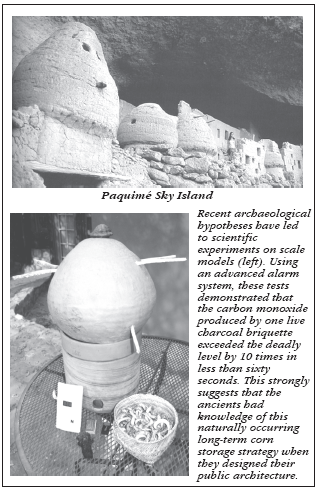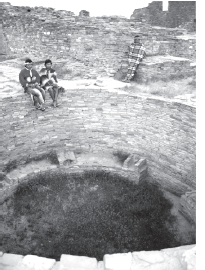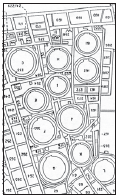| |
Granaries with unique design features have been known to exist in the Northern Sierra Madre Mountains associated with the Trincheras and Paquimé cultural system for over a hundred years.
| Pueblo Bonito right and below |
|
In the past decade granary systems have also been found at several Salado sites, including School House Point Mound and Pumpkin Center, which is known as Granary Row Locus 2. Evidence of other granaries is found at Canyon Creek and in the San Pedro Valley, in central and southern Arizona, and in the Mimbres area of southwestern New Mexico. All of these appear to be late date post-Chaco sites.
The archaeological debate whether the smaller “kivas” at Chaco (AD 850-1130) were actually corn storage silos continues. In the Paquimé (AD 1250-1425) culture region, however, the silos or granaries are self-evident. Corn must be stored at 12% or less moisture content or it will mold. Silo (kiva) “benches” and horizontal wood beam pilasters, like those found in Chaco Canyon, NM, “kivas,” may have supported a latticework floor with an air space beneath to keep the corn dry (bottom right). The space for the horizontal wood beam pilasters are clearly visible on the exterior of the Paquimé granary (top right). In both cases, these extensive and large granaries indicate corn was widely grown throughout the region and then centralized for storage. In the Paquimé culture region the corn was dried, stored, and then transported to Paquimé itself, approximately 75 miles from the Sky Island site. At Chaco, the corn was grown up to 75-100 miles away, transported to the central outliers, and then transported again for storage in Chaco Canyon villages such as Pueblo Bonito. Transhumance agriculture is strongly supported by the evidence in this unique architecture.
The collection of fertile water and the corn storage strategy gave the Anasazi and Paquimé peoples the ability to survive many short term and a number of severe long term droughts (below).
|
|
 |
|





